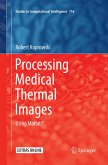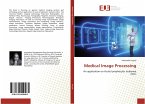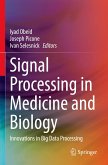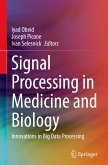Real-Time Medical Image Processing
Herausgegeben:Onoe, Morio
Real-Time Medical Image Processing
Herausgegeben:Onoe, Morio
- Broschiertes Buch
- Merkliste
- Auf die Merkliste
- Bewerten Bewerten
- Teilen
- Produkt teilen
- Produkterinnerung
- Produkterinnerung
In order to rea1ize real-time medica1 imaging systems, such as are used for computed tomography, automated miscroscopy, dynamic radioisotope imaging, etc., special techno1ogy is required. The high-speed image sour ce must be successfu11y married with the u1tra high-speed computer. Usua11y the ordinary genera1-purpose computer is found to be inadequate to the image generation and/or image pro cessing task. The ordinary computer executes instructions at be tween 1 and 10 million per second. Speed has improved by only about a factor of 10 during the past 20 years. In contrast a typical com puter…mehr
Andere Kunden interessierten sich auch für
![Laser Applications in Medicine and Biology Laser Applications in Medicine and Biology]() Myron WolbarshtLaser Applications in Medicine and Biology39,99 €
Myron WolbarshtLaser Applications in Medicine and Biology39,99 €![Medical Imaging Techniques Medical Imaging Techniques]() Medical Imaging Techniques77,99 €
Medical Imaging Techniques77,99 €![Dental Image Analysis for Disease Diagnosis Dental Image Analysis for Disease Diagnosis]() Kavindra R. JainDental Image Analysis for Disease Diagnosis64,99 €
Kavindra R. JainDental Image Analysis for Disease Diagnosis64,99 €![Processing Medical Thermal Images Processing Medical Thermal Images]() Robert KoprowskiProcessing Medical Thermal Images74,99 €
Robert KoprowskiProcessing Medical Thermal Images74,99 €![Medical Image Processing Medical Image Processing]() Mohamed KayyaliMedical Image Processing40,99 €
Mohamed KayyaliMedical Image Processing40,99 €![Signal Processing in Medicine and Biology Signal Processing in Medicine and Biology]() Signal Processing in Medicine and Biology81,99 €
Signal Processing in Medicine and Biology81,99 €![Signal Processing in Medicine and Biology Signal Processing in Medicine and Biology]() Signal Processing in Medicine and Biology81,99 €
Signal Processing in Medicine and Biology81,99 €-
-
-
In order to rea1ize real-time medica1 imaging systems, such as are used for computed tomography, automated miscroscopy, dynamic radioisotope imaging, etc., special techno1ogy is required. The high-speed image sour ce must be successfu11y married with the u1tra high-speed computer. Usua11y the ordinary genera1-purpose computer is found to be inadequate to the image generation and/or image pro cessing task. The ordinary computer executes instructions at be tween 1 and 10 million per second. Speed has improved by only about a factor of 10 during the past 20 years. In contrast a typical com puter used in recognizing blood cell images at 10,000 per hour must execute instructions at between 1 billion and 10 billion per second. Simi1ar execution rates are required to construct a computed tomogra phy image in real-time (1 to 10 seconds). For the reasons given above, engineering development in image generation and processing in the field of biomedicine has become a discipline unto itself;a discipline wherein the computer engineer is driven to design extremely high-speed machines that far surpass the ordinary computer and the x-ray, radioisotope, or microscope scanner designer must also produce equipment whose specifications extend far beyond the state-of-the-art.
Produktdetails
- Produktdetails
- Verlag: Springer / Springer US / Springer, Berlin
- Artikelnr. des Verlages: 978-1-4757-0123-4
- Softcover reprint of the original 1st ed. 1980
- Seitenzahl: 272
- Erscheinungstermin: 18. Mai 2012
- Englisch
- Abmessung: 254mm x 178mm x 15mm
- Gewicht: 522g
- ISBN-13: 9781475701234
- ISBN-10: 1475701233
- Artikelnr.: 40910592
- Verlag: Springer / Springer US / Springer, Berlin
- Artikelnr. des Verlages: 978-1-4757-0123-4
- Softcover reprint of the original 1st ed. 1980
- Seitenzahl: 272
- Erscheinungstermin: 18. Mai 2012
- Englisch
- Abmessung: 254mm x 178mm x 15mm
- Gewicht: 522g
- ISBN-13: 9781475701234
- ISBN-10: 1475701233
- Artikelnr.: 40910592
General.- Towards an Image Analysis Center for Medicine.- 1. Introduction.- 2. The Interactive Image Analysis System.- 2.1 The Input Units.- 2.2 The Image Display System.- 2.3 The Computer System.- 3. The Computerized Microscope.- 3.1 The Input System.- 3.2 The Computer System.- 3.3 The Microscope Stage Controller.- 4. Discussion.- 5. Acknowledgements.- 6. References.- Cellular Computers and Biomedical Image Processing.- 1. Introduction.- 2. Cellular Computers.- 2.1 The von Neumann Cellular Automaton.- 2.2 Cellular Automata and Image Processing.- 2.3 Pipeline Image Processor.- 3. Cellular Computers and Image Processing Research.- 3.1 Programming the Cellular Computer.- 3.2 Research Status.- 4. Biomedical Applications of Cellular Digital Image Processing.- 4.1 Coronary Artery Disease.- 4.2 Tissue Growth and Development.- 4.3 Genetic Mutagen Studies.- 5. References.- Radiology.- Ultra High-Speed Reconstruction Processors for X-Ray Computed Tomography of the Heart and Circulation.- 1. Introduction.- 2. Computation and Display.- 2.1 The Cone Beam Geometry.- 2.2 Choice of a Suitable Reconstruction Algorithm.- 2.3 Filtration Methods.- 2.4 Reconstruction Processor Design.- 2.5 Back-Projection Implementations.- 3. Flexibility of the High Speed Parallel Processing Reconstruction Architecture.- 4. Acknowledgements.- 5. References.- Computer Analysis of the Ultrasonic Echocardiogram.- 1. Introduction.- 2. System Configuration.- 3. Processing of Ultrasonic Echocardiogram.- 4. Clinical Results.- 5. Conclusions.- 6. Acknowledgements.- 7. References.- Toward Computed Detection of Nodules in Chest Radiographs.- 1. Introduction.- 2. Materials and Methods.- 2.1 Preprocessor.- 2.2 Circularity Detector.- 2.3 Boundary Follower.- 2.4 Classifier.- 3. Experimental Results.- 4. Conclusions.- 5. Acknowledgements.- 6. References.- A Parallel Processing System for the Three-Dimensional Display of Serial Tomograms.- 1. Introduction.- 2. System Outline.- 2.1 Tomograms.- 2.2 Functions.- 3. System Architecture.- 4. Image Input Device.- 5. Image Processing.- 5.1 Reduction of Size.- 5.2 Smoothing.- 5.3 Binarization.- 5.4 Differentiation.- 5.5 Rotation.- 6. Three-Dimensional.- 7. Illustrative Experiment.- 8. Concluding Remarks.- 9. Acknowledgements.- 10. References.- Dynamic Computed Tomography for the Heart.- 1. Introduction.- 2. Dynamic Scanner.- 2.1 CT Images Using the Dynamic Scanner.- 2.2 ECG Gated Image Using the Dynamic Scanner.- 2.3 ECG Phase Differentiation Method.- 2.4 Comparison of Methods.- 3. Proposed Method for Faster Synchronization.- 3.1 Multilens Method.- 3.2 Rocking Fan Beam Method.- 4. Conclusion.- 5. References.- Efficient Analysis of Dynamic Images Using Plans.- 1. Introduction.- 2. Hardware System.- 3. Analysis of Heart Wall Motion in Cine-Angiograms.- 3.1 Plan-Guided Analysis of Thickness of the Heart Wall.- 3.2 Input Pictures.- 3.3 Planning for Feature Extraction.- 3.4 Efficient Heuristic Search for Smooth Boundaries.- 3.5 Selection of Frames for Analysis.- 3.6 Analysis of Consecutive Frames.- 3.7 Measurement of Wall Thickness.- 4. Conclusion.- 5. Acknowledgements.- 6. References.- Real-Time Image Processing in CT-Convolver and Back Projector.- 1. Introduction.- 2. Image Processing in CT.- 3. System Configuration.- 4. High Speed Processor.- 4.1 Convolution.- 4.2 Back Projection.- 4.3 Processing Time.- 5. Display System.- 6. References.- Histology and Cytology.- Detection of the Spherical Size Distribution of Hormone Secretory Granules from Electron Micrographs.- 1. Introduction.- 2. Materials and Methods.- 2.1 Manual Method for Size Distribution Analysis.- 2.2 Computer Method for Size Distribution Analysis.- 2.3 Analysis.- 3. Results.- 4. Discussion.- 5. Conclusion.- 6. References.- The Abbott Laboratories ADC-500T.M..- 1. Introduction.- 1.1 Rationale.- 1.2 Rate-Limiting Factors.- 2. Sample Preparation.- 2.1 The Spinner.- 2.2 The Stainer.- 3. Real-Time Blood Cell Image Analysis.- 3.1 The Computer-Controlled Microscope.- 3.2 Cell Acquisition.- 3.3 High Resolution Data Analysis.- 3.4 Cell Classification.- 3.5 System Timing.- 3.6 Review.- 4. Results.- 5. Summary and Conclusion.- 6. Future Trends.- 7. References.- An Approach to Automated Cytotoxicity Testing by Means of Digital Image Processing.- 1. Introduction.- 2. The Principle of the Lymphocytotoxicity Test.- 3. Description of Our Instrument.- 3.1 Image Input Device.- 3.2 Autofocusing Algorithm.- 3.3 Thresholding.- 3.4 Binary Pattern Matching.- 3.5 Cell Counting.- 4. Important Parameters to Determine Positivity.- 4.1 Cell Size.- 4.2 Density.- 4.3 Halo.- 5. Experimental Results.- 6. Summary.- 7. Acknowledgements.- 8. References.- The diff3T.M. Analyzer: A Parallel/Serial Golay Image Processor.- 1. Introduction.- 2. Functional Organization.- 3. Automated Microscope.- 3.1 Optics.- 3.2 Optical Bench.- 4. Golay Image Processor.- 4.1 Golay Logic Processor (GLOPR).- 4.2 Application of GLOPR.- 5. Summary.- 6. References.- Computer-Aided Tissue Stereology.- 1. Introduction.- 2. Analysis of Muscle Biopsies.- 3. Analysis of the Placenta.- 4. Analysis of Adipose Tissue.- 5. Computer-Aided Data Capture.- 6. Choice of Method.- 7. Acknowledgements.- 8. References.- Interactive System for Medical Image Processing.- 1. Introduction.- 2. Using the SUPRPIC Interactive Image Processing System.- 2.1 Cellular Logic for Image Processing.- 2.2 The Command Structure of SUPRPIC.- 3. Examples of Using SUPRPIC.- 3.1 Digitizing the Image.- 3.2 Determination of Tissue Image Architecture.- 4. Summary and Conclusions.- 5. References.- Real-Time Image Processing in Automated Cytology.- 1. Introduction.- 2. System Design and Specifications.- 2.1 System Design.- 2.2 System Specifications.- 3. Image Input.- 3.1 Image Input System Design.- 3.2 Image Sensor Module.- 3.3 Screening Module.- 3.4 Automated Focusing Module.- 4. Feature Extraction Method.- 4.1 Feature Extraction Hardware.- 4.2 Feature Extraction Procedure.- 5. Processing Sequence.- 6. Conclusion.- 7. References.- The Development of a New Model Cyto-Prescreener for Cervical Cancer.- 1. Introduction.- 2. Fundamental Ideas.- 2.1 Improvement of Diagnostic Performance.- 2.2 Improvement of Processing Speed.- 2.3 Automatic Slide Preparation.- 3. Improvement of Diagnostic Performance.- 3.1 Improvement of Cell Image Quality.- 3.2 Addition of Morphological Feature Parameters.- 3.3 Improvement of Preprocessing Program for Feature Extraction.- 3.4 Increase in Number of Cells Analyzed.- 4. Hardware Implementation.- 4.1 High Resolution TV Camera.- 4.2 Automatic Focusing Mechanism.- 4.3 High Speed Image Processor.- 4.4 Flexible Controllers.- 4.5 Automatic Smear Preparation.- 5. Conclusion.- 6. Acknowledgement.- 7. References.- Author Index.
General.- Towards an Image Analysis Center for Medicine.- 1. Introduction.- 2. The Interactive Image Analysis System.- 2.1 The Input Units.- 2.2 The Image Display System.- 2.3 The Computer System.- 3. The Computerized Microscope.- 3.1 The Input System.- 3.2 The Computer System.- 3.3 The Microscope Stage Controller.- 4. Discussion.- 5. Acknowledgements.- 6. References.- Cellular Computers and Biomedical Image Processing.- 1. Introduction.- 2. Cellular Computers.- 2.1 The von Neumann Cellular Automaton.- 2.2 Cellular Automata and Image Processing.- 2.3 Pipeline Image Processor.- 3. Cellular Computers and Image Processing Research.- 3.1 Programming the Cellular Computer.- 3.2 Research Status.- 4. Biomedical Applications of Cellular Digital Image Processing.- 4.1 Coronary Artery Disease.- 4.2 Tissue Growth and Development.- 4.3 Genetic Mutagen Studies.- 5. References.- Radiology.- Ultra High-Speed Reconstruction Processors for X-Ray Computed Tomography of the Heart and Circulation.- 1. Introduction.- 2. Computation and Display.- 2.1 The Cone Beam Geometry.- 2.2 Choice of a Suitable Reconstruction Algorithm.- 2.3 Filtration Methods.- 2.4 Reconstruction Processor Design.- 2.5 Back-Projection Implementations.- 3. Flexibility of the High Speed Parallel Processing Reconstruction Architecture.- 4. Acknowledgements.- 5. References.- Computer Analysis of the Ultrasonic Echocardiogram.- 1. Introduction.- 2. System Configuration.- 3. Processing of Ultrasonic Echocardiogram.- 4. Clinical Results.- 5. Conclusions.- 6. Acknowledgements.- 7. References.- Toward Computed Detection of Nodules in Chest Radiographs.- 1. Introduction.- 2. Materials and Methods.- 2.1 Preprocessor.- 2.2 Circularity Detector.- 2.3 Boundary Follower.- 2.4 Classifier.- 3. Experimental Results.- 4. Conclusions.- 5. Acknowledgements.- 6. References.- A Parallel Processing System for the Three-Dimensional Display of Serial Tomograms.- 1. Introduction.- 2. System Outline.- 2.1 Tomograms.- 2.2 Functions.- 3. System Architecture.- 4. Image Input Device.- 5. Image Processing.- 5.1 Reduction of Size.- 5.2 Smoothing.- 5.3 Binarization.- 5.4 Differentiation.- 5.5 Rotation.- 6. Three-Dimensional.- 7. Illustrative Experiment.- 8. Concluding Remarks.- 9. Acknowledgements.- 10. References.- Dynamic Computed Tomography for the Heart.- 1. Introduction.- 2. Dynamic Scanner.- 2.1 CT Images Using the Dynamic Scanner.- 2.2 ECG Gated Image Using the Dynamic Scanner.- 2.3 ECG Phase Differentiation Method.- 2.4 Comparison of Methods.- 3. Proposed Method for Faster Synchronization.- 3.1 Multilens Method.- 3.2 Rocking Fan Beam Method.- 4. Conclusion.- 5. References.- Efficient Analysis of Dynamic Images Using Plans.- 1. Introduction.- 2. Hardware System.- 3. Analysis of Heart Wall Motion in Cine-Angiograms.- 3.1 Plan-Guided Analysis of Thickness of the Heart Wall.- 3.2 Input Pictures.- 3.3 Planning for Feature Extraction.- 3.4 Efficient Heuristic Search for Smooth Boundaries.- 3.5 Selection of Frames for Analysis.- 3.6 Analysis of Consecutive Frames.- 3.7 Measurement of Wall Thickness.- 4. Conclusion.- 5. Acknowledgements.- 6. References.- Real-Time Image Processing in CT-Convolver and Back Projector.- 1. Introduction.- 2. Image Processing in CT.- 3. System Configuration.- 4. High Speed Processor.- 4.1 Convolution.- 4.2 Back Projection.- 4.3 Processing Time.- 5. Display System.- 6. References.- Histology and Cytology.- Detection of the Spherical Size Distribution of Hormone Secretory Granules from Electron Micrographs.- 1. Introduction.- 2. Materials and Methods.- 2.1 Manual Method for Size Distribution Analysis.- 2.2 Computer Method for Size Distribution Analysis.- 2.3 Analysis.- 3. Results.- 4. Discussion.- 5. Conclusion.- 6. References.- The Abbott Laboratories ADC-500T.M..- 1. Introduction.- 1.1 Rationale.- 1.2 Rate-Limiting Factors.- 2. Sample Preparation.- 2.1 The Spinner.- 2.2 The Stainer.- 3. Real-Time Blood Cell Image Analysis.- 3.1 The Computer-Controlled Microscope.- 3.2 Cell Acquisition.- 3.3 High Resolution Data Analysis.- 3.4 Cell Classification.- 3.5 System Timing.- 3.6 Review.- 4. Results.- 5. Summary and Conclusion.- 6. Future Trends.- 7. References.- An Approach to Automated Cytotoxicity Testing by Means of Digital Image Processing.- 1. Introduction.- 2. The Principle of the Lymphocytotoxicity Test.- 3. Description of Our Instrument.- 3.1 Image Input Device.- 3.2 Autofocusing Algorithm.- 3.3 Thresholding.- 3.4 Binary Pattern Matching.- 3.5 Cell Counting.- 4. Important Parameters to Determine Positivity.- 4.1 Cell Size.- 4.2 Density.- 4.3 Halo.- 5. Experimental Results.- 6. Summary.- 7. Acknowledgements.- 8. References.- The diff3T.M. Analyzer: A Parallel/Serial Golay Image Processor.- 1. Introduction.- 2. Functional Organization.- 3. Automated Microscope.- 3.1 Optics.- 3.2 Optical Bench.- 4. Golay Image Processor.- 4.1 Golay Logic Processor (GLOPR).- 4.2 Application of GLOPR.- 5. Summary.- 6. References.- Computer-Aided Tissue Stereology.- 1. Introduction.- 2. Analysis of Muscle Biopsies.- 3. Analysis of the Placenta.- 4. Analysis of Adipose Tissue.- 5. Computer-Aided Data Capture.- 6. Choice of Method.- 7. Acknowledgements.- 8. References.- Interactive System for Medical Image Processing.- 1. Introduction.- 2. Using the SUPRPIC Interactive Image Processing System.- 2.1 Cellular Logic for Image Processing.- 2.2 The Command Structure of SUPRPIC.- 3. Examples of Using SUPRPIC.- 3.1 Digitizing the Image.- 3.2 Determination of Tissue Image Architecture.- 4. Summary and Conclusions.- 5. References.- Real-Time Image Processing in Automated Cytology.- 1. Introduction.- 2. System Design and Specifications.- 2.1 System Design.- 2.2 System Specifications.- 3. Image Input.- 3.1 Image Input System Design.- 3.2 Image Sensor Module.- 3.3 Screening Module.- 3.4 Automated Focusing Module.- 4. Feature Extraction Method.- 4.1 Feature Extraction Hardware.- 4.2 Feature Extraction Procedure.- 5. Processing Sequence.- 6. Conclusion.- 7. References.- The Development of a New Model Cyto-Prescreener for Cervical Cancer.- 1. Introduction.- 2. Fundamental Ideas.- 2.1 Improvement of Diagnostic Performance.- 2.2 Improvement of Processing Speed.- 2.3 Automatic Slide Preparation.- 3. Improvement of Diagnostic Performance.- 3.1 Improvement of Cell Image Quality.- 3.2 Addition of Morphological Feature Parameters.- 3.3 Improvement of Preprocessing Program for Feature Extraction.- 3.4 Increase in Number of Cells Analyzed.- 4. Hardware Implementation.- 4.1 High Resolution TV Camera.- 4.2 Automatic Focusing Mechanism.- 4.3 High Speed Image Processor.- 4.4 Flexible Controllers.- 4.5 Automatic Smear Preparation.- 5. Conclusion.- 6. Acknowledgement.- 7. References.- Author Index.








